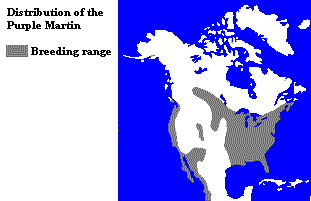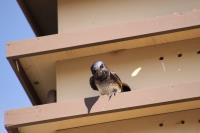Part I: Introduction to Purple Martins
Identification
The Purple Martin, or Progne subis, is a large swallow in the family Hirundinidae of the order Passiformes. This species is the largest swallow found in Canada (Canadian Wildlife Federation). Iridescence creates a blueish-purple colouration on adult male Purple Martins. The wings and tail are black or brown. Female and juvenile individuals have a gray colouration, a fairly white belly, and are dull in appearance in comparison to the males of this species (The Cornell Lab of Ornithology). It takes around two years for Purple Martins to develop their full adult plumage. There are four classes of this species that can be aged and sexed by plumage during the breeding season: adult female, subadult female, adult male, and subadult male. Adult males are the only class to have full iridescent purple colouring (Purple Martin Conservation Association). The bright plumage of these males does not aid in deterring competitors for territory (Stutchbury, 1992).





These birds measure at about 19-20cm in length, with a wingspan of 39-71cm (The Cornell Lab of Ornithology). Their tails are forked and short. Purple Martins have long wings with the distinctive tapered shape seen in swallows (The Cornell Lab of Ornithology). Their bills are somewhat hooked, which aids them in consuming the larger insects that they feed upon. Moths, deer flies, and dragonflies are among their favourite flying meals (Canadian Wildlife Federation).
Vocalizations
Purple Martins have a variety of calls and songs, each with a different purpose. Females use Choo calls with their hatchlings, and chortle songs during courtship. Males court females using the Croak song and use Hee-Hee calls to scare away intruders in their territories. Both males and females use Zwrack calls, Zweet calls, Cher calls, and Chortle calls. Males also use a vocalization known as the Dawnsong to attract other males to their colony. These males are followed by more female Martins, so already-established males use the Dawnsong in the hopes of bringing more potential mates to their territory (Purple Martin Conservation Association). Juveniles use a monosyllabic call while in the nest, usually when their parents arrive to feed them (Brown, 1984).
Range
Purple Martins breed in Eastern North America, and roost along the Gulf Coast in the late summer. They have been known to migrate over Central America and the Gulf of Mexico (The Cornell Lab of Ornithology).
In Canada, the Purple Martin breeds in Southern Canada, parts of Manitoba, Saskatchewan, and Alberta. Purple Martins can be found on Southern Vancouver Island, Southwestern mainland, and the Peace River region of British Columbia. It is much more common to find these birds in Eastern Canada than in Western Canada. In April or May, Purple Martins arrive in Canada, and begin migrating south in July and August (Canadian Wildlife Federation).

Breeding and nesting
Purple Martins will occasionally nest alone, but are most often found nesting in colonies (Canadian Wildlife Federation). Tree hollows, woodpecker holes, crevices in cliffs, and nest boxes are common choices for nesting. Purple Martins lay four to five eggs in a clutch during the summer months. Females incubate their eggs for 15-18 days before they hatch. As babies are born without feathers, their mother will brood them for 7-8 days (Canadian Wildlife Federation). Both parents are responsible for feeding their young up to 60 times each day! Parents sometimes continue to feed their young even after they leave the nest at 28-35 days old (Canadian Wildlife Federation).
Nesting boxes
Purple Martins have mostly nested in martin houses for the past century (Stutchbury, 1991). Purple Martins will nest in regular bird houses with one compartment, but they prefer “bird apartments” that allow a colony to nest together (Canadian Wildlife Federation). Males will claim rooms in the apartment and are often found fighting over a room that has already been occupied. Some males even claim several rooms in an attempt to attract multiple mates. Females then arrive at the apartment and shop around from room to room before choosing a mate (Canadian Wildlife Federation).
Good Martin apartment design is crucial for the safety of these birds. Without large enough rooms, the heat of the summer can end up killing hatchlings. White apartments are best for deflecting heat and keeping the birds cool. Proper ventilation and a drainage system help keep the birds healthy in their homes. Martin lodgings are set on top of a pole that should be approximately 5m high. In an effort to protect Martin nests from ground predators, these poles can be greased to prevent predators such as squirrels, cats, or racoons from climbing up. Even snakes attempt to ascend the pole to prey on Martin eggs and hatchlings (Canadian Wildlife Federation).

Part II: Tenants through History
Habitat loss due to human activity, as well as the introduction of invasive species such as the European Starling, have caused Purple Martins to turn to nest boxes more often than their natural nesting sites (Jervis et al., 2019). This species is known to be “synanthropic”, meaning that they live near humans relatively comfortably. Different subspecies of Purple Martins have varying levels of dependence on human aid. Many people who provide nesting boxes for these birds are considered to be their “landlords”. This practice of “landlording” dates back as far as the early nineteenth century, and it has been speculated to have been practiced even earlier. First Nations peoples purposely drew Purple Martins to their crops to protect them from pest damage. Martins were effective in reducing insect populations around the crops and drove off crop-damaging birds such as blackbirds. Indigenous peoples provided housing for the martins in the form of gourds hanging on saplings. It has also been suggested that First Nations peoples dried and powdered the bodies of Purple Martins in order to create a treatment for furs to protect them from damage by insects (Jervis et al., 2019). In the late nineteenth century, commercial manufacturing of nesting boxes for Purple Martins began. Some of these nest boxes were so elaborate that they were modeled after multi-story houses complete with windows, porches, and railings (Jervis et al., 2019).
With European colonization of North America came habitat destruction that started a decline in Purple Martin populations (Jervis et al., 2019). The introduction of species such as the European Starling increased competition for nesting sites, and led to a greatly increased martin dependence on manmade nesting boxes (Jervis et al., 2019). Although Purple Martins are considered to be a low concern for risk of extinction, their populations have been declining, and those that landlord for this species are worried. On top of increased dependence on nesting boxes, the population of Purple Martin Landlords is aging, and with low interest from younger generations, these landlords are concerned that once they pass on, no one will provide the martins with the lodging that they require. In an effort to support future martin populations, these landlords are mentoring younger people in their part in martin conservation (Jervis et al., 2019). Citizen participants in Purple Martin studies and conservation efforts indicate that their biggest motivation for participating is to aid a species in need and to learn more about that species (Hvenegaard & Fraser, 2014).
References
Purple Martin Conservation Association. Accessed November 3, 2020. https://www.purplemartin.org/
Wow, this is super cool! Question about the population numbers on Purple Martins, do you know how many are left approximately?
There are approximately 7 million left globally, and they’ve been declining by about 1% per year since the late 1960’s. Thanks for reading!
Hey Viv,
Really cool blog post, especially the part where one purple martin can take up multiple apartment rooms. Do you think that we should aim to decrease the Purple Martin’s dependence on humans, and if so, how should we go about doing that?
Thanks,
Ian
Hey Ian,
I think that it would be good to decrease the Purple Martins’ dependence on humans. A way to do so could be by preserving and protecting their natural nesting habitats. However, this species does seem to have a preference for nest boxes over natural nesting sites, so it would likely be difficult to decrease their dependence on nest boxes. Competition for natural nesting sites from invasive species would also make it harder for Purple Martins to become more independent from human aid. Thanks for reading!
Viv
Hi Vivian,
Nice blog. Did you come across anything in your researching about how food availability might delay nesting? Or how far parents will forage away from the nest when feeding nestlings?
Thanks for sharing your love of PUMA!
Cheers,
Sam
Hi Sam,
I didn’t find any information on whether decreased food availability could delay nesting, but that would be an interesting topic to explore. I couldn’t find any specific information on how far away PUMA will search for food when feeding nestlings, but as they feed them up to 60 times a day I would imagine they don’t go too far! I did find out that they will travel more than 5 miles from their nesting site in search of food, but it was not specified whether they do so when feeding hatchlings.
Thanks for reading!
Vivian
Hi Vivian!
Very interesting about the apartments! I was curious if European starlings are the biggest threat to nest invasion or if Purple Martins, like other swallow species are affected by House Sparrows too?
Julia
Hi Julia,
Yes, House Sparrows also aggressively compete with Purple Martins for nesting sites. Both House Sparrows and European Starlings will go so far as to kill adult Martins to steal a nesting site. Thanks for reading!
Vivian
Hi Vivian,
Thanks for writing your blog on PUMAs, they are probably my favorite type of swallow! My fascination for them it think first started in Alberta, as I used to have a little “condo” set up for them! You said that their species are declining, do you know if there are any recovery programs for PUMAs in Canada?
Thanks for the great read!
Madi
Hi Madi,
Thanks for reading my blog! Nature Canada has a Save Our Swallows program which includes providing housing for Purple Martins. The Ontario Purple Martin Association assists with this project as well as providing resources and information for people wanting to provide housing for Purple Martins.
Cheers
Vivian